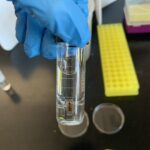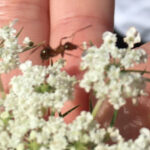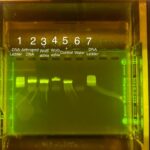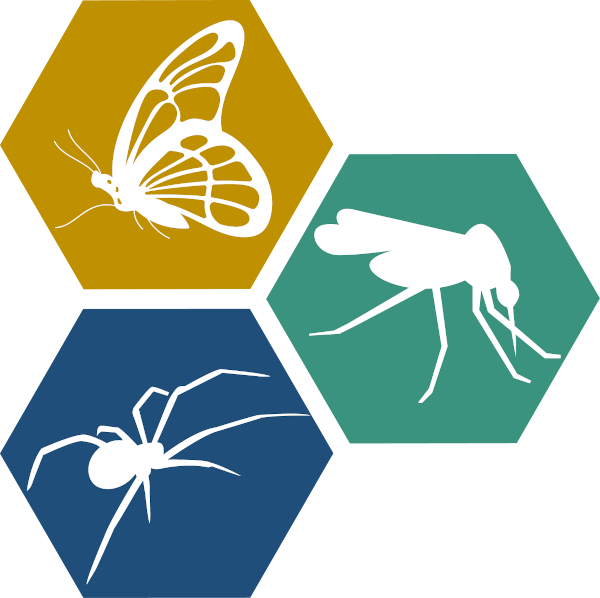Sample information |
|
| Picture |


|
|---|---|
| Location | |
| Collection date | 09/14/2021 |
| Captive / Cultivated? | Wild-caught |
| Group | Woburn Memorial High School |
| Observations | Formica Ant caught in the baseball fields behind Woburn Memorial High School! The ant appeared to be rather minuscule with a mixture of brown and deep red coloring. |
| Putative identification | Arthropoda Insecta |
Methods |
|
| Extraction kit | Edwards Buffer |
| DNA extraction location | Abdomen |
| Single or Duplex PCR | Duplex Reaction |
| Gel electrophoresis system | MiniOne |
| Buffer | TBE |
| DNA stain | GelGreen |
| Gel images |

|
| Protocol notes | Primarily, the series of labs under the Wolbachia project–DNA Extraction, PCR of Wolbachia and Verification of Wolbachia in PCR by Gel Electrophoresis–were conducted to isolate DNA from organisms and determine if there is Wolbachia present or not (through the use of PCR). Moreover, the arthropod samples collected on 9/14/21 (see page 71 for information regarding arthropod sample) were lysed, then used for DNA extraction to collect DNA samples; PCR was then used to amplify the CO1 gene present in arthropods and the W16S gene that is associated with Wolbachia. This series of labs did not have any form of hypothesis, but did in fact have specified predictions for the base pair sizes of the bands that were expected to be seen on the gel: samples with Arthropod DNA were predicted to have a band with 708 base pairs and Wolbachia presence was expected to have a band with 438 base pairs. Furthermore, after extracting DNA from the samples collected and amplifying the desired genes through PCR, gel electrophoresis was used to verify whether Wolbachia, or even Arthropod DNA were present in the collected samples. To truly verify the results through gel electrophoresis, a set of sample controls were used as precautions to make sure that the results produced were valid– cross-contamination or invalidation of data would be shown through these controls, as well as a successful GE run or positive/negative sample results. The wells of GE, in order, included: DNA Ladder, the Arthropod sample (Formica Ant), the control positive for Wolbachia, the control negative for Wolbachia, the positive DNA Control, Water (the negative control), and another DNA Ladder–each of these were seven microliters in volume. After the results were run for the entire class, it became evident that a majority of the samples were difficult to read and interpret, so the samples were eventually re-reun. The first run (3/18/22, see page 78, ‘First Run’), though streaky looking, proved to be rather successful. The positive Wolbachia lane had the 438 bp signifying a presence of Wolbachia and a 708 bp signifying the presence of arthropod DNA, the negative Wolbachia lane only had a 708 bp size (meaning only arthropod DNA was present), the DNA control had two bands: a base pair of 708 and 438 (arthropod DNA and wolbachia respectively), and the negative control lane had no bands present, as predicted. Finally, the collected Formica Ant sample DNA in lane 2 was practically identical to the positive Wolbachia control bands, meaning that the sample was in fact an arthropod and did carry the Wolbachia bacteria (see page 78, Well 2, ‘First Run’). As mentioned previously, these samples were rerun on 3/24/22, however the same exact results that occurred on the first run, occurred on the second run–except these results were cleaner than the first run (see page 78, ‘Second Run’, to compare results). All in all, the Formica Ant DNA sample did contain Wolbachia, as hoped. |
Results |
|
| Wolbachia presence | Yes |
| Confidence level | High |
| Explanation of confidence level | I am extremely confident that my arthropod was infected with Wolbachia because the controls worked effectively–not to mention that my sample (seen in Lane 2) matched the positive Wolbachia control perfectly! |
| Wolbachia 16S sequence |
Provided by Wolbachia Project
BLAST at The Wolbachia Project BLAST at NCBI
|
| Arthropod COI sequence |
Provided by Wolbachia Project
BLAST at The Wolbachia Project BLAST at NCBI
|
| Summary | The Insecta was found to be postive for Wolbachia. |
 Bombus impatients (Eastern Bumblebee)
Bombus impatients (Eastern Bumblebee) Agelenopis
Agelenopis My Data
My Data Common Eastern Bumble Bee (Bombus impatiens)
Common Eastern Bumble Bee (Bombus impatiens) American Bird
American Bird